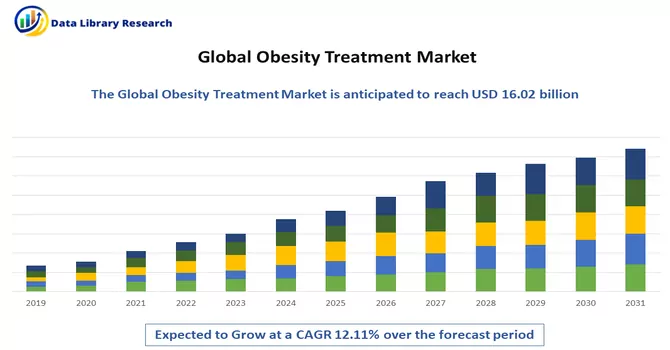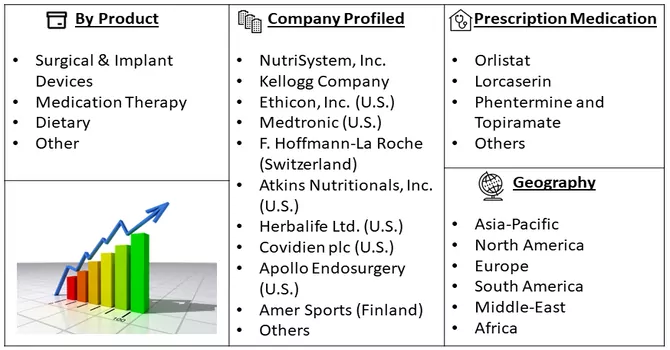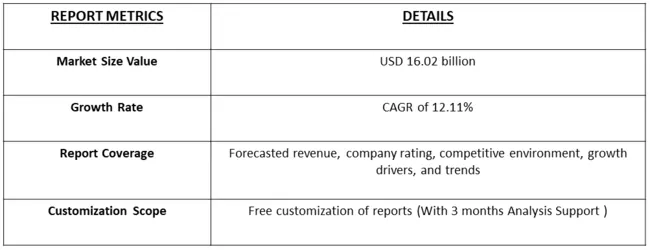The global obesity treatment market was valued at USD 16.02 billion in 2023 and is expected to grow at a CAGR of 12.11% during the forecast period, 2024-2031.

Get Complete Analysis Of The Report - Download Free Sample PDF
The obesity treatment market is witnessing significant growth as the global prevalence of obesity continues to rise. Obesity, characterized by excessive accumulation of body fat, is a complex medical condition associated with various health risks, including cardiovascular diseases, diabetes, and certain cancers. With increasing awareness about the adverse health effects of obesity and the growing emphasis on preventive healthcare measures, there is a rising demand for effective obesity management solutions.
The market offers a wide range of treatment options, including lifestyle modifications, pharmacotherapy, surgical interventions, and medical devices. Lifestyle interventions, such as diet and exercise programs, remain the cornerstone of obesity management, but pharmaceutical interventions, including prescription medications and over-the-counter supplements, are gaining traction. Bariatric surgery, such as gastric bypass and sleeve gastrectomy, is increasingly performed for individuals with severe obesity or obesity-related comorbidities. Additionally, the development of innovative medical devices, such as gastric balloons and neuromodulation devices, is contributing to the expansion of the obesity treatment market. With the increasing recognition of obesity as a global public health concern, coupled with advancements in treatment modalities and growing healthcare investments, the obesity treatment market is poised for significant growth in the coming years. The obesity treatment market is primarily driven by the rising global prevalence of obesity and associated health risks. Factors such as sedentary lifestyles, unhealthy dietary habits, and genetic predispositions contribute to the increasing incidence of obesity worldwide. Consequently, there is a growing awareness among individuals and healthcare providers about the importance of addressing obesity and its related complications. This awareness has led to an uptick in demand for effective obesity management solutions, including lifestyle interventions, pharmacotherapy, and surgical procedures. Moreover, advancements in medical technology and treatment modalities, coupled with increasing research and development activities in the field of obesity management, are further driving the growth of the market. Additionally, supportive government initiatives, rising healthcare expenditure, and the availability of reimbursement policies for obesity treatments are also contributing factors. Overall, the growing recognition of obesity as a significant public health concern and the continuous efforts to develop innovative and effective treatment options are fueling the expansion of the obesity treatment market.
Market Segmentation: The obesity treatment market Product Types is Segmented by (Surgical & Implant Devices, Medication Therapy, Dietary, Other), Prescription Medication (Orlistat, Lorcaserin, Phentermine and Topiramate, and Others) and Geography (North America, Europe, Asia-Pacific, Middle East and Africa, and South America). The report offers the value (in USD million) for the above segments.

For Detailed Market Segmentation - Download Free Sample PDF
In the obesity treatment market, several key trends are shaping the landscape. Firstly, there's a growing emphasis on personalized and multidisciplinary approaches to obesity management. Healthcare providers are increasingly recognizing that effective treatment requires tailored interventions that address the unique needs and challenges of individual patients. This trend has led to the development of comprehensive obesity management programs that combine dietary counseling, physical activity interventions, behavioral therapy, and pharmacotherapy as needed. Additionally, there's a rising adoption of minimally invasive and non-invasive procedures for obesity treatment. With advancements in medical technology, procedures such as gastric balloon placement, endoscopic sleeve gastroplasty, and neuromodulation techniques are gaining popularity as less invasive alternatives to traditional bariatric surgery. Moreover, there's a growing focus on digital health solutions and telemedicine in obesity management. Mobile apps, wearable devices, and online platforms are being used to deliver remote monitoring, education, and support to individuals seeking to manage their weight. These digital tools not only enhance patient engagement and adherence to treatment but also enable healthcare providers to deliver more personalized and accessible care. Overall, these trends reflect the evolving landscape of obesity treatment towards more patient-centered, minimally invasive, and digitally enabled approaches.
Market Drivers:
Increasing Obesity Prevalence:
The rising prevalence of obesity worldwide is a significant driver for the obesity treatment market. Factors such as sedentary lifestyles, unhealthy dietary habits, urbanization, and genetic predisposition contribute to the growing obesity epidemic. As obesity rates continue to climb across age groups and regions, there is a greater demand for effective treatments to address the associated health risks and improve quality of life. This sustained demand fuels investment in research and development of new obesity treatment modalities, pharmaceuticals, and medical devices.
Healthcare Initiatives and Policies:
Government initiatives, public health campaigns, and policy interventions aimed at combating obesity play a crucial role in driving the obesity treatment market. Governments and healthcare organizations worldwide are increasingly focusing on obesity prevention and management through measures such as promoting healthy eating, physical activity, and weight management programs. Additionally, policies targeting the food industry, such as regulations on labeling, marketing, and taxation of sugary beverages and unhealthy foods, influence consumer behavior and contribute to the demand for obesity treatment options. These initiatives create a conducive environment for innovation, investment, and adoption of obesity treatment interventions, driving market growth.
Market Restraints:
One significant market restraint for the obesity treatment market is the complex nature of obesity itself. Obesity is a multifactorial condition influenced by genetic, environmental, behavioral, and socio-economic factors, making it challenging to develop universally effective treatments. Individuals with obesity often face barriers to accessing healthcare services, including limited insurance coverage for obesity treatment, stigma, and discrimination. Moreover, the long-term management of obesity requires sustained lifestyle modifications, behavioral changes, and adherence to treatment regimens, which can be difficult for many patients. Additionally, the high cost associated with obesity treatment, including medications, surgical procedures, and lifestyle interventions, may pose a barrier to affordability and accessibility for some individuals. These challenges underscore the need for comprehensive and personalized approaches to obesity management and highlight the importance of addressing social determinants of health to effectively tackle the obesity epidemic.
The COVID-19 pandemic has significantly impacted the obesity treatment market in several ways. Firstly, individuals with obesity are at a higher risk of severe illness and complications from COVID-19, leading to increased demand for obesity management and treatment services. However, the pandemic has also disrupted healthcare systems worldwide, leading to the postponement or cancellation of elective procedures, including bariatric surgeries and in-person consultations with healthcare providers. This has resulted in delays in obesity treatment and management for many patients. Additionally, lockdowns, social distancing measures, and economic uncertainties have contributed to changes in lifestyle behaviors, such as reduced physical activity levels, increased sedentary behavior, and altered dietary habits, which may exacerbate obesity and weight-related health issues. Furthermore, the economic impact of the pandemic has affected individuals' ability to afford obesity treatment services, including medications, dietary supplements, and weight management programs. As the world continues to grapple with the ongoing effects of the pandemic, addressing the challenges faced by the obesity treatment market will be crucial in mitigating the long-term impact of COVID-19 on obesity and related health outcomes.
Segmental Analysis:
Medication Therapy Segment is Expected to Witness Segment is Expected to Witness Significant Growth Over the Forecast Period
Medication therapy is pivotal in managing peripheral neuropathy, focusing on alleviating symptoms, enhancing quality of life, and preventing complications. Commonly used medications include pain relievers like acetaminophen or NSAIDs for mild to moderate pain, and opioids for severe pain, albeit with restricted use due to dependency risks. Antidepressants such as TCAs and SNRIs are effective in altering neurotransmitter levels to mitigate neuropathic pain. Anticonvulsants like gabapentin and pregabalin stabilize nerve activity. Topical treatments like lidocaine patches offer localized relief. Emerging NGF inhibitors like tanezumab target pain signal transmission. With the increasing prevalence of diabetes and other conditions causing peripheral neuropathy, the demand for effective medications is rising, spurring research for new and improved therapies.
Lorcaserin Segment is Expected to Witness Segment is Expected to Witness Significant Growth Over the Forecast Period
Lorcaserin is a weight-loss medication that was approved by the FDA in 2012 but was withdrawn from the market in 2020 due to safety concerns. It worked by affecting serotonin receptors in the brain, helping people feel full with smaller meals. While lorcaserin is not directly related to the treatment of peripheral neuropathy, its withdrawal from the market may have indirect effects on the peripheral neuropathy market. The withdrawal of lorcaserin from the market could potentially impact the peripheral neuropathy market in several ways. For example, individuals who were using lorcaserin to manage their weight may now seek alternative weight-loss medications or strategies, which could lead to changes in their overall health status and the development or progression of conditions such as diabetes, which is a common cause of peripheral neuropathy. Additionally, the withdrawal of lorcaserin may also impact the pharmaceutical industry's approach to developing and marketing weight-loss medications. It could lead to increased scrutiny of safety and efficacy standards for these medications, potentially influencing the development of new treatments for conditions like peripheral neuropathy.
North America Region is Expected to Witness Segment is Expected to Witness Significant Growth Over the Forecast Period
North America is a significant region for the peripheral neuropathy market, driven by several factors including the high prevalence of diabetes, advanced healthcare infrastructure, and increasing awareness about neuropathic conditions. Peripheral neuropathy is a common complication of diabetes, which affects a large proportion of the population in North America. The region is also home to a large number of pharmaceutical companies and research institutions that are actively involved in the development of new treatments for peripheral neuropathy. This has led to the availability of a wide range of treatment options, including medications, physical therapies, and alternative treatments. Furthermore, the high level of awareness about peripheral neuropathy among healthcare providers and patients in North America has led to early diagnosis and intervention, which is crucial for managing the condition and preventing complications. Thus, North America is a key region for the peripheral neuropathy market, with a combination of high prevalence rates, advanced healthcare infrastructure, and robust research and development activities driving growth in the market.

Get Complete Analysis Of The Report - Download Free Sample PDF
The analyzed market exhibits a high degree of fragmentation, primarily attributable to the presence of numerous players operating on both a global and regional scale. The competitive landscape is characterized by a diverse array of companies, each contributing to the overall market dynamics. This fragmentation arises from the existence of specialized solution providers, established industry players, and emerging entrants, all vying for market share. The diversity in market participants is underscored by the adoption of various strategies aimed at expanding the company presence. On a global scale, companies within the studied market are strategically positioning themselves through aggressive expansion initiatives. This often involves entering new geographical regions, targeting untapped markets, and establishing a robust global footprint. The pursuit of global expansion is driven by the recognition of diverse market opportunities and the desire to capitalize on emerging trends and demands across different regions. Simultaneously, at the regional level, companies are tailoring their approaches to align with local market dynamics. Regional players are leveraging their understanding of specific market nuances, regulatory environments, and consumer preferences to gain a competitive edge. This regional focus allows companies to cater to the unique needs of local clientele, fostering stronger market penetration. To navigate the complexities of the fragmented market, companies are implementing a range of strategies. These strategies include investments in research and development to stay at the forefront of technological advancements, mergers and acquisitions to consolidate market share, strategic partnerships for synergies, and innovation to differentiate products and services. The adoption of such multifaceted strategies reflects the competitive nature of the market, with participants continually seeking avenues for growth and sustainability. In essence, the high fragmentation in the studied market not only signifies the diversity of players but also underscores the dynamism and competitiveness that drive ongoing strategic maneuvers. As companies explore various avenues for expansion, the market continues to evolve, presenting both challenges and opportunities for industry stakeholders.
Some of the key market players:
Recent Developments:
1) In September 2021, Allergan Plc (AbbVie) announced that the US Food and Drug Administration (FDA) approved its once-weekly GLP-1 receptor agonist, Semaglutide, for the treatment of obesity. The drug is expected to provide a new treatment option for patients struggling with obesity and associated conditions such as type 2 diabetes.
2) In 2020, Novo Nordisk A/S announced the launch of a new once-weekly injectable weight loss drug, Ozempic, for the treatment of obesity. The drug is based on the GLP-1 receptor agonist, semaglutide, and is expected to have a significant impact on the obesity treatment market.
Q1. What was the Obesity Treatment Market size in 2023?
As per Data Library Research the global obesity treatment market was valued at USD 16.02 billion in 2023.
Q2. At what CAGR is the Obesity Treatmentmarket projected to grow within the forecast period?
Obesity Treatment Market is expected to grow at a CAGR of 12.11% during the forecast period
Q3. What are the factors driving the Obesity Treatment market?
Key factors that are driving the growth include the Increasing Obesity Prevalence and Healthcare Initiatives and Policies.
Q4. Which Region is expected to hold the highest Market share?
North America Region is expected to hold the highest Market share.
Data Library Research are conducted by industry experts who offer insight on industry structure, market segmentations technology assessment and competitive landscape (CL), and penetration, as well as on emerging trends. Their analysis is based on primary interviews (~ 80%) and secondary research (~ 20%) as well as years of professional expertise in their respective industries. Adding to this, by analysing historical trends and current market positions, our analysts predict where the market will be headed for the next five years. Furthermore, the varying trends of segment & categories geographically presented are also studied and the estimated based on the primary & secondary research.
In this particular report from the supply side Data Library Research has conducted primary surveys (interviews) with the key level executives (VP, CEO’s, Marketing Director, Business Development Manager and SOFT) of the companies that active & prominent as well as the midsized organization
FIGURE 1: DLR RESEARH PROCESS

Extensive primary research was conducted to gain a deeper insight of the market and industry performance. The analysis is based on both primary and secondary research as well as years of professional expertise in the respective industries.
In addition to analysing current and historical trends, our analysts predict where the market is headed over the next five years.
It varies by segment for these categories geographically presented in the list of market tables. Speaking about this particular report we have conducted primary surveys (interviews) with the key level executives (VP, CEO’s, Marketing Director, Business Development Manager and many more) of the major players active in the market.
Secondary ResearchSecondary research was mainly used to collect and identify information useful for the extensive, technical, market-oriented, and Friend’s study of the Global Extra Neutral Alcohol. It was also used to obtain key information about major players, market classification and segmentation according to the industry trends, geographical markets, and developments related to the market and technology perspectives. For this study, analysts have gathered information from various credible sources, such as annual reports, sec filings, journals, white papers, SOFT presentations, and company web sites.
Market Size EstimationBoth, top-down and bottom-up approaches were used to estimate and validate the size of the Global market and to estimate the size of various other dependent submarkets in the overall Extra Neutral Alcohol. The key players in the market were identified through secondary research and their market contributions in the respective geographies were determined through primary and secondary research.
Forecast Model
